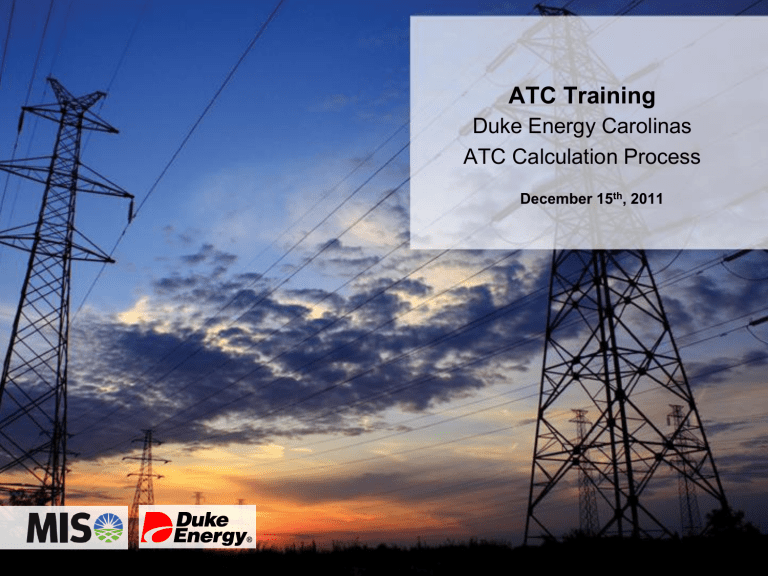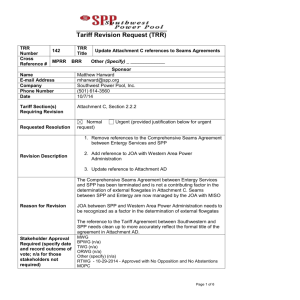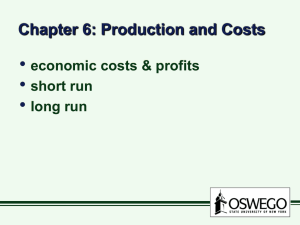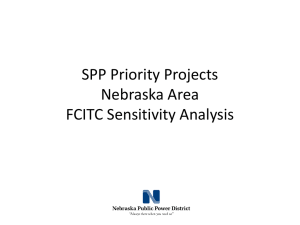What is a Flowgate?

ATC Training
Duke Energy Carolinas
ATC Calculation Process
December 15 th , 2011
Agenda
• Objectives
• Introduction
• Flowgate methodology basics
• Data Inputs
• AFC Calculation
• Posted ATC
2
ATC Training
Objectives
3
Objectives
• High-level understanding of new Available Transfer
Capability (ATC) Process
– Inputs to the ATC process
– How inputs affect the ATC process
– Transfer Distribution Factors (TDFs)
– How ATC is calculated
4
ATC Training
Introduction
5
How Did We Get Here?
2007 2008 2009
Change Order signed with OATi
Discussion on switching to AFC begins
Sep
Aug
Dec
2011
Decision made to switch to AFC
Jan
2010
Evaluation of FERC order 729/676-E impacts
Mar
OATi delivered
AFC system to test
Tested AFC process
Implemented AFC process
Legislative Timeline
Feb
2007 2008
FERC order 890
2009
Nov
2010
FERC orders
729/676-E
2011
Apr
Effective date of
FERC orders 729/676-E
Effective date of
NERC MOD Standards
6
Duke Energy Carolinas ATC Process
• Implemented the Flowgate Methodology
– NERC MOD-030 Reliability Standard
•
Two (2) main components to process
– Model Builder (PowerGEM TARA AMB)
– ATC Calculator (OATi webTrans)
•
Automated Process
• Increased the level of required coordination with other
TSPs
– TSRs
– Tags
– Outages
– AFC Values
– Flowgates
– Generation Dispatch Files
– Load Forecasts
7
ATC Training
Flowgate Methodology Basics
8
What is a Flowgate?
• NERC defines a Flowgate as:
– A mathematical construct, comprised of one or more monitored transmission Facilities and optionally one or more contingency
Facilities, used to analyze the impact of power flows upon the Bulk Electric System.
•
More simply put:
– A Flowgate is a transmission line or transformer that is being monitored for overloads incurred by normal operating conditions or for loss of another transmission line or transformer
9
Flowgate Identification
• Flowgate identification is performed at least annually
– Identifies list of Flowgates internal to Duke Energy Carolinas
– Screens external Flowgates and includes those that meet/exceed criteria
• An external TSP can request Duke Energy Carolinas to incorporate their Flowgates into the Duke Energy Carolinas process
• Duke ATC process currently contains 670 Flowgates
– 379 internal DUK Flowgates & 291 External Flowgates
Breakout of Flowgates in Duke Process by TSP
DUK CPL PJM SC SCEG SOCO TVA Total
379 56 82 62 50 29 12 670
10
What is AFC?
• Available Flowgate Capability
• NERC defines AFC as:
– A measure of the flow capability remaining on a Flowgate for further commercial activity over and above already committed uses.
•
More simply put:
– AFC is the commercial capability remaining on the Flowgate.
11
ATC Training
Data Inputs
12
ATC Process Overview
External TSP
AFC Overrides
Adjacent TSP
Reservations
Duke TSP flowgates
External TSP flowgates
FG Definition File
Seed Case
Outages
Load Forecast
Tags
Gen Dispatch Files
Adjacent TSP Gen
Dispatch Files
Shift
Factors
Base Flow
TFC
Duke
Reservations
ATC
13
Adjacent TSP TSRs
• Process includes TSRs from adjacent TSPs
– Old process only contained DUK TSRs
– Filtered to remove duplicate TSRs
– Must have TDF greater than 5%
• Adjacent TSRs provided by adjacent TSP
– Availability/accuracy based on adjacent TSP
• ATC Calculator downloads/applies Adjacent TSP TSRs
– OATi webTrans
– Applies Adjacent TSP TSRs at horizon initialization
• Coordinating TSPs
– CPL, PJM, SC, SCEG, SOCO, SEHA, SETH, TAP, TVA, YAD
14
External TSP Flowgates
• Duke Energy Carolinas includes Flowgates outside of its system in the ATC process
– Called “External Flowgates”
– Owned by another Transmission Service Provider (TSP)
• Flowgates that are not owned by Duke Energy Carolinas
– Includes any Flowgate in the VACAR Reliability Coordinator
Area that had a TLR called in past 12 months
• At the time the list of Flowgates was created
– Any TSP can request Duke Energy Carolinas to honor their
Flowgates
• Must be included in requesting TSP’s ATC process
• Must already be modeled
• Must pass Flowgate screening test
15
External TSP AFC Overrides
• Duke Process Includes AFC Overrides from adjacent
TSPs
– Applied to External Flowgates
– Replaces (overrides) the AFC value calculated by DUK
• Provided by coordinating TSP
– Availability/accuracy based on adjacent TSP
• If provided, DUK is REQUIRED to use the AFC value.
• If not provided, DUK utilizes value calculated by DUK process
• ATC Calculator downloads/applies External AFC
Overrides
– OATi webTrans applies AFC Overrides at horizon initialization
• Horizon definitions are included in the ATCID ( link )
16
Seed Case
• Starting point powerflow model
– Inputs of the AFC process (Outages, Load, etc) modify the Seed
Case to create a model representative of the calculation period
•
Based on SERC Near-Term Study Group OASIS Studies
– Model is modified to account for mapping concerns (alignment with NERC IDC, SDX, etc) and handling of base case transfers
• ensure that outages, load forecasts, etc can be mapped correctly
• avoid double counting of TSR or tag impacts in the calculation of
AFCs.
– Developed quarterly for next 5 seasons
17
Outages
• Download Outages from NERC SDX
– Industry standard database
– Transmission & generation outages
– Utilize outages from:
• Duke Energy Carolinas
• All adjacent TSPs
• Outages built into Seed Case
– Refer to the outage criteria in the ATCID ( link )
• Transmission Outages are viewable on OASIS
– Requires certificate
– Only Duke Energy Carolinas
18
Load Forecasts
• Download load data from NERC SDX
– Industry standard database
– Utilize data from:
• Duke Energy Carolinas
• All adjacent TSPs, except PJM
•
Download load data from PJM
– PJM provides a file that breaks out their load into each legacy
BA (increases model accuracy)
• Forecasted/Actual Load Data are viewable on OASIS
– Requires certificate
– Only Duke Energy Carolinas
• System load
• Native load
19
Tags
• Download tag data from NERC Tag Dump
– Industry standard database
– Utilize data from:
• Duke Energy Carolinas
• All adjacent TSPs
•
Modeling of Tags
– Capacity modeled is the Transmission Profile MWs
– Utilize the GCA/LCA to model receipt & delivery points
• Adjusts net area interchange of GCA/LCA
• Tag impacts will be due to physics, not market path
– IPPs internal to DUK utilize the Source & LCA
• Adjusts the output of the specific generator and the net area interchange of GCA/LCA
20
Tags Continued…
• Tags affect the amount of generation dispatched in the
Duke Energy Carolina TSP area
– Generation is dispatched to meet load + net area interchange + losses
– Tags sinking in Duke will decrease the generation dispatched
– Tags sourcing from Duke will increase the generation dispatched
•
Tags will impact the amount of generation dispatched which impacts baseflows of impacted Flowgates
– Based on physics not the market path
– Some Flowgates are more sensitive to generation than others
21
Generation Dispatch Files
• Duke Energy Carolinas generation dispatch
– Block Dispatch File
• Groups units into blocks based on dispatch order (typically economics)
– Direct Dispatch Files
• Pumped Storage (based on Duke unit commitment 7-day outlook forecast)
• IPPs – Based on tags in hourly operating horizon
• Adjacent TSP generation dispatch
– Block Dispatch File (provided by adjacent TSP)
– Direct Dispatch Files (if provided)
22
ATC Training
AFC Calculation
23
ATC Process Overview
External TSP
AFC Overrides
Adjacent TSP
Reservations
Duke TSP flowgates
External TSP flowgates
FG Definition File
Seed Case
Outages
Load Forecast
Tags
Gen Dispatch Files
Adjacent TSP Gen
Dispatch Files
Shift
Factors
Base Flow
TFC
Duke
Reservations
ATC
24
Baseflows
• Calculated by the Model Builder (PowerGEM TARA AMB)
– MW flow on each flowgate
– Imported to ATC Calculator (OATi webTrans)
– Baseflow values are adjusted to prevent double impacts
• Performed in the ATC Calculator (OATi webTrans)
25
Shift Factors (GSFs)
• Generation Shift Factors (GSFs) measures the sensitivity of a flowgate due to an incremental change in generation dispatch from a subsystem
– Subsystem created for each Control Area (CA) in Eastern
Interconnect
• Each company represented by an import & export subsystem
• Duke process contains roughly 106 subsystems
– Each subsystem has a factor relating to each Flowgate
• 106 subsystems X 670 Flowgates = 71,020 sensitivity factors for each powerflow snapshot
– Hourly48 file contains 71,020 X 48 hours = 3,408,960 sensitivity factors
26
Transfer Distribution Factors (TDFs)
• Portion of a transaction that flows across a Flowgate
– Expressed as a percentage (%)
•
Based on Generation Shift Factors (GSFs)
– TDF = GSF
POR
– GSF
POD
– Means TDF is dependent on the Source (POR) & Sink (POD)
Control Areas (CAs) change in generation dispatch to facilitate the transfer
•
Used to determine/calculate:
– How much each TSR impacts a Flowgate
– Which Flowgates impact a Path
– The ATC of a Path
27
How much will my TSR impact a particular
Flowgate?
• Depends on the TDF
– TSR Flowgate Impact = Granted MW Capacity X TDF
• Will need to calculate TSR impact on each impacted
Flowgate
• Example: TSR = 100 MW
– TDF on Flowgate “A” = -2.32%
• TSR Flowgate Impact (Flowgate A) = 100 X -2.32% = -2.32 MWs
– TDF on Flowgate “B” = 5.01%
• TSR Flowgate Impact (Flowgate B) = 100 X 5.01% = 5.01 MWs
28
Which Flowgates impact Path “XYZ”?
• Depends on the TDF of each Flowgate
– If Flowgate TDF >= to Flowgate threshold, Flowgate is impacted
• 3% for Duke Flowgates
• 5% for all other Flowgates
• Example:
– Using the threshold above, what Flowgates impact DUK-PJM?
• TDF on Flowgate “A” = -.0232 (-2.32%) owned by DUK
– Does not impact DUK-PJM, Flowgate TDF < Flowgate threshold (3%)
• TDF on Flowgate “B” = .0501 (5.01%) owned by TVA
– Impacts DUK-PJM, Flowgate TDF (5.01%) > Flowgate threshold (5%)
• Remember TDFs are based on Shift Factors (GSFs)
– Means TDF is dependent on how the Source (POR) & Sink
(POD) CAs respond to a Flowgate
29
Example
Why is there ATC on CPLE-PJM but not DUK-PJM?
• Completely different and independent Paths
• Because the two Paths are different, Flowgates impact the Paths differently
– TDFs are based on Shift Factors (GSFs)
– Means TDF for each Flowgate is dependent POR & POD
• Path DUK-PJM has POR = DUK & POD = PJM
• Path CPLE-PJM has a POR = CPLE & POD = PJM
– Paths are not the same
• Because POR & POD are not the same
30
Example
- Why is there ATC on CPLE-PJM but not DUK-PJM?
DUK-PJM
PJM generation is scaled down for import
PJM
Gen scaled down
CPLE-PJM
PJM generation is scaled down for import
PJM
Gen scaled down
DUK
No changes
DUK generation does not change
DUK
Gen scaled up
The Difference Is
Flowgates can be more sensitive to gen dispatch in one area vs another area
DUK generation is scaled up for export
CPLE
Gen scaled up
CPL generation is scaled up for export
31
ATC Training
Process Timing &Calculation of Posted ATC
32
ATC Process Overview
External TSP
AFC Overrides
Adjacent TSP
Reservations
Duke TSP flowgates
External TSP flowgates
FG Definition File
Seed Case
Outages
Load Forecast
Tags
Gen Dispatch Files
Adjacent TSP Gen
Dispatch Files
Shift
Factors
Base Flow
TFC
Duke
Reservations
ATC
33
ATC Process Timing Schedule
• Calculation of ATC values
– ATC adjusted automatically as TSRs change status
• Uses existing model output (baseflows, sensitivity factors, etc.)
– ATC recalculated automatically as Model Builder data imported
– ATC recalculated at horizon initialization
• ATC Calculator Inputs
– OATi monitors coordinating TSPs for data downloads
• TSRs
• AFCs
– Model Builder data
• OATi monitors FTP site every 15 mins for data
34
ATC Process Timing Schedule Continued…
• Model Builder Data
– Script runs hourly to download the following inputs:
• Load forecasts, Outages, Tags
– Model creation schedule:
Model Series
Hourly Non-Firm
(near-term)
Hourly Firm
(near-term)
Hourly
(long-term)
Daily
Monthly
Frequency
Every hour
(5 mins after hour)
Every hour
(5 mins before hour)
7:30, 12:30, 15:30, 23:30
7:15, 14:30, 22:30
9:30, 13:30, 21:30
Only required to be updated once/day
Only required to be updated once/month
– Model Builder data sent to FTP site for ATC Calculator
35
Posted ATC
• How is ATC calculated?
– It is the minimum of the equivalent ATC from the AFC methodology and the Remaining Contract Path Capability
(RCPC)
• Ensures Flowgates are respected as well as the contract path interface limits
• ATC calculated by “ATC Calculator”
– OATi webTrans software used as “ATC Calculator”
– Exports ATCs to OASIS System Data & Offerings
36
Posted ATC Continued…
• Converting AFCs to an ATC equivalent
– Driven by AFC value and TDF of each flowgate relative to path
– Calculated by following the two steps below:
• Divide every “impacted” Flowgate AFC by it’s associated path TDF
– “Impacted” Flowgates are those who’s TDFs are >= to the threshold
(3% for internal Flowgates or 5% for external Flowgates)
• The equivalent ATC is the minimum value from the above calculations
• Remaining Contract Path Capability (RCPC)
– Similar to old Area Interchange Methodology (aka Contract Path)
37
Wrap up
• Change to AFC Methodology driven by new NERC MOD
Standards
– NERC significantly changed the standard related to our old Area
Interchange Methodology (aka Contract Path Methodology)
• Process frequency significantly increased
– Automated process to run more frequently than our previous
Area Interchange Methodology. To meet/excede requirements.
• This process is much more dependent on data
– Most inputs are dynamic and can change throughout the day
– Utilizes significantly more data from other companies
• The points mentioned above cause a dynamic calculation
– ATC values will change as data inputs change
– Values should be better aligned with actual system conditions
38
For More Information…
• ATCID – Posted on OASIS ( link )
• Attachment C of the OATT – posted on OASIS ( link )
• ATC Methodology Contact
– dukencieatc@misoenergy.org
– (651) 632-8708
• Is there a need for additional ATC/AFC training?
– Was this presentation helpful?
39
Questions?
•
E-mail: dukencieatc@misoenergy.org
• Phone: (651) 632 ‐ 8708
40
ATC Training
Appendix
41
ATC Process Overview
External TSP
AFC Overrides
Adjacent TSP
Reservations
Duke TSP flowgates
External TSP flowgates
FG Definition File
Seed Case
Outages
Load Forecast
Tags
Gen Dispatch Files
Adjacent TSP Gen
Dispatch Files
Shift
Factors
Base Flow
TFC
Duke
Reservations
ATC
42
Transfer Distribution Factors (TDFs)
Continued…
• How do you calculate a TDF for a particular Flowgate?
– Example: What is the TDF of Flowgate A with respect to the
DUK-CPLE Path
• TDF = GSF
POR
– GSF
POD
• From table below: GSF
POR
= DUK_R = -.0036
GSF
POD
= CPLE_D = .01696
• TDF = -.0036 - .0196 = -.0232 = -2.32%
43
Converting AFCs to an ATC equivalent
ATC
AFC
= min(P)
P ={PATC
1
, PATC
2
,…PATC n
}
PATC n
= AFC n
/ DF np
Where:
ATC
AFC
P
PATC n
AFC n
DF np
= ATC of a Path p based on AFCs
= set of partial ATCs for all “impacted” Flowgates of Path p
= partial ATCs for a Path relative to a Flowgate n
= AFC of Flowgate n
= Distribution Factor of Flowgate n relative to the Path p
44
Remaining Contract Path Calculation
• Remaining Contract Path Capability (RCPC)
– Represents the remaining capacity of Contract Path
– Similar to old Area Interchange Methodology (aka Contract Path)
Firm Equation – All Horizons
RCPC = CP Limit – TRM – CBM - Conf Firm TSRs
Non-Firm Equation – Prior to 08:00 day prior
RCPC = CP Limit – TRM – CBM – Conf Firm TSRs – Conf Non-Firm TSRs
Non-Firm Equation – After 08:00 day prior
RCPC = CP Limit – TRM – CBM – Sch Firm – Conf Non-Firm TSRs
45








